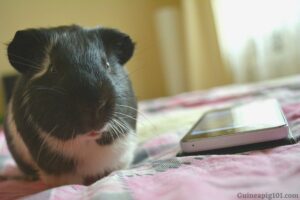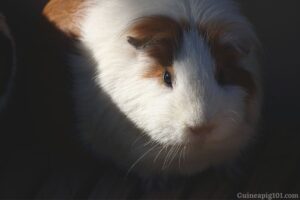That could be a time-consuming process, but it is necessary if you want to take your guinea pigs outside, especially if they will be in an open area where they could run away and become separated.
As a result, we will cover everything related to the collar and harness in this article. We will also investigate which one is the most beneficial for your guinea pigs.
Are collars safe for guinea pigs?
A guinea pig’s owner can attach a belt to the animal’s collar and take the animal for a walk. That could be a fantastic way to encourage your guinea pig to get some exercise on his or her own.
Collars for guinea pigs are associated with a number of risks. If you’re thinking about putting a collar on your guinea pig, keep these guidelines in mind:
- An owner should ensure that the guinea pig is comfortable wearing a collar before releasing it. If your guinea pig is adamant about not wearing a collar, don’t force him or her to do so.
- Choose a collar that is the exact size you need. It should be large enough for your guinea pig to be able to breathe comfortably, but not large enough for it to slip around the corner.
- When your guinea pig is wearing a collar, you should never jerk the lead. Guinea pigs have brittle, fragile bones, which makes them difficult to handle.
- Always keep an eye out to make sure that the collar does not become entangled with another external object.
- Keep the lead attached to an insentient object at all times and never leave your guinea pig unattended.
- Check that the edge is long enough and that it can be extended. It is possible that your guinea pig will dummy or run unintentionally while wearing the collar. It is possible that your guinea pig will be strangled as a result of this.
A guinea pig collar can be useful in a variety of other situations. The owner can include contact information in the attachment. If your guinea pig manages to get away, you will be notified as soon as it is captured.
Can guinea pigs wear harnesses?
Harnesses appear to be safer for guinea pigs than collars, according to research. The harness ensures that the weight of the guinea pig is evenly distributed throughout its body.
It is not necessary to worry about harming your guinea pig if you move it quickly while it is harnessed.
A guinea pig harness will be fastened with buckles or velcro to keep it in place.
Similarly, when it comes to collars, proper fit is critical. Opt for a harness that allows you to slip your two index and middle fingers beneath it.
Make sure you don’t let it go to waste, as this could result in your guinea pig escaping from the cage. Your guinea pig will run away and become nearly impossible to keep up with as a result of this.
In order to train the guinea pigs to move quickly and easily, which is also known as agility training, a harness is frequently used. Some guinea pigs are enthusiastic about agility training, while others are adamant about not participating.
You should always use a harness whenever you plan to exercise or otherwise handle your guinea pig while on a lead.
You must put in a lot of effort into training them. It will take some time for your guinea pig to become accustomed to wearing it, as it is not something that comes naturally to him.
It’s also important to remember that guinea pigs aren’t nearly as intelligent as dogs, which makes it extremely difficult for you to lead train one of them.
Table of Contents
Best harness for guinea pig
The best harness for the guinea pig is the one that fits the best. There are three types of harness.
- The H-style: This is very easy to put on, and your guinea pig will also breathe easily.
- The mesh harness: This harness is also very comfortable and breathable.
- The vest harness: This harness has a good hold.
The vest harness is the most suggested as it gives enough comfort to your guinea pig. The owner should be careful when slipping the harness on and ensure it fits comfortably.
Always try to put your two fingers beneath the harness to make sure that it is fit and comfortable for your guinea pig.
Ensure that your guinea pig is not getting hurt by the harness. Some of the symptoms to detect that if your guinea pig is getting hurt are:
- Irritability
- Fear of contact
- Loss of hair around the area
- Nervousness
Immediately stop using the harness once you detect any of the above issues in your guinea pig.
Tips to use harness safely with your guinea pigs
The owner should always make sure that the harness is not too tight. A too-loose harness can also be a problem, as a guinea pig can easily slip away from that and escape. Avoid regularly using the harness every time.
Some of the owners of guinea pigs have been reported back injuries because of the regular use of a harness. It is also suitable for the owner to limit the time of using the harness.
Sometimes putting a harness in your guinea pig can make them feel as if they have been trapped.
Immediately remove the harness from your guinea pig when you come to know that your guinea pig is not comfortable or being stressed.
You should train your guinea pig before planning to attach a harness. You can hold them in the same place where the harness is attached so that they get familiar with the contact in that area.
How to harness train a guinea pig
If you want to train your mind to walk your guinea pig on a leash, you will need to do some preliminary training. That will be a time-consuming process. It’s unlikely that your guinea pig will ever walk next to you in a straight line, matching the rhythm of your footsteps.
The very first step in training your guinea pig is to introduce him to harnesses for the first time.
Place it on the floor and wait for your guinea pig to come up to it. If your guinea pig appears to be having fun with the harness, then everything is fine.
Your guinea pig will eventually lose interest in the sight of its harness after a short period of time. Convincing your guinea pig to wear the item is the very next step to take.
Attach the harness, making a big deal about it the entire time. Make sure your guinea pig gets their favorite treat, and make sure they are wearing a harness for at least twenty minutes at a time.
Don’t rush through the process of raising your guinea pig. Allow your guinea pig to wear the harness for the first few days of training to ensure a smooth transition.
Your guinea pig will be able to tell you whether or not he is comfortable with it.
The best course of action is to surrender if your guinea pig is chewing and struggling with the harness after a period of time. You are only going to make your guinea pig’s suffering worse.
When you’re ready, attach a lead to your guinea pig’s collar and begin walking him around your house. Every once in a while, give the most gentle pull you possibly can manage. Walking on a lead will become more natural as a result of this exchange of energy.
Your guinea pig will be more comfortable when you take it for a walk around the backyard after it has been lead trained in your home. Soon, your guinea pig will be self-assured and will be able to cover a large amount of ground.
Can you take a guinea pig for a walk?
The majority of the guinea pigs are not enthusiastic about being led around. Guinea pigs are self-sufficient creatures.
Attaching a point to a harness and walking your guinea pig, on the other hand, can be beneficial. It is the only way to get a nervous guinea pig to move around. Your guinea pig may become more courageous as a result of this.
It’s possible that your guinea pig will require some physical recovery time. A guinea pig suffering from illness or injury may experience a lack of energy. It is necessary to take your guinea pig for a walk with you in order to encourage him to become more active again.
In the event that you decide to begin walking your guinea pig, make certain that you do not take your guinea pig onto public streets.
Potential threats while taking your guinea pig’s outside
Taking your guinea pig out on the street can be very dangerous. There are several dangers related to taking guinea pigs outside:
- All the visuals smell, and the sounds of the outdoors can end up overwhelming your guinea pig. That all will panic your guinea pig.
- If your guinea pig is enjoying being outdoors, they will grow quickly excited. That could result in their breaking free from the harness and escape. They can break out from their enclosure.
- Guinea pigs use their mouth to explore the world. Your guinea pig will eat and lick all types of dangerous things. That can result in intestinal blockage.
- Guinea pigs are not vaccinated against various kinds of diseases, and also they have a weak immune system. Guinea pigs can get in contact with multiple conditions while walking around the streets.
- In the end, your guinea pig’s interest will take over. They will wish to explore the new world on their own. They can hurt themselves by pulling on the lead.
- Guinea pigs can face danger everywhere. Neighborhood cats and dogs can appear from apparently anywhere, as can wild birds.
Guinea pig walking on a lead should always be a temporary thing. Being an independent animal, your guinea pig will still want to run free in the end. You should always encourage this behavior of your guinea pig.
Guinea pigs will always get more exercise this way. It will just take a while to get it there.
You should never use harness on a regular basis. It is something that can be used once in a while when you want to take your guinea pig’s outside.
Conclusion
We came to know that a guinea pig can wear harness from all the above information. The harness seems to be safer than the collar.
The harness provides an even distribution of weight. The owner should take care that you will need to train your guinea pig before preparing your guinea pig to wear a harness.
The owner should take care of the fitness of the harness or collars. Harness should not be too tight, which can make your guinea pig struggling to breathe.
It should also not be too loose so that your guinea pig can slip away and escape. In any case, you detect that your guinea pig is feeling uncomfortable wearing harness, immediately take out the harness from your guinea pig as it can cause stress to your guinea pig.
Taking your guinea pig out on the street can be a bad idea, as your guinea pig will be stressed by the visuals, sound, and smell of the outside world.
They can come with contact with various diseases as guinea pigs explore the whole world through their mouth.




